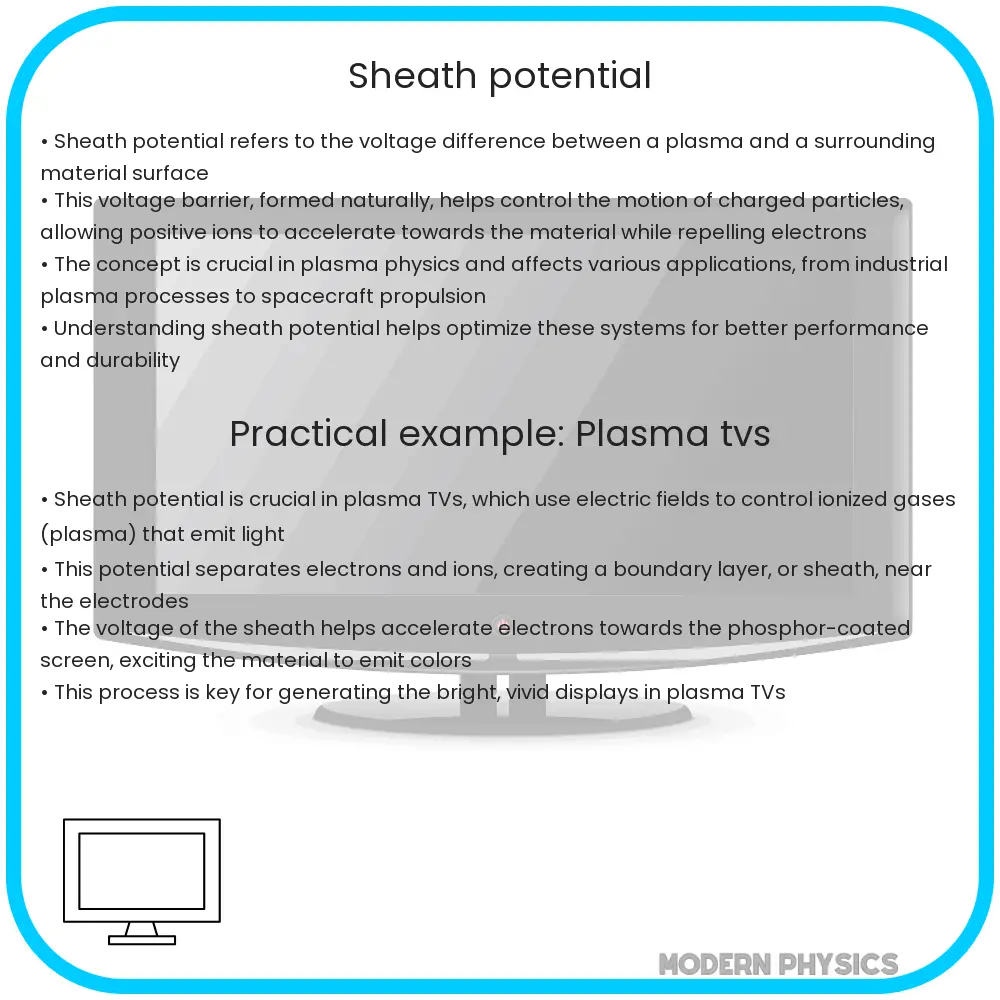Explore the critical role of sheath potential in plasma physics, its impact on technology and diagnostics, and the future of plasma applications and research.

Understanding Sheath Potential in Plasma Physics
Sheath potential plays a critical role in the dynamics of plasma, the fourth state of matter, which is a collection of free-moving ions and electrons. Plasma is ubiquitous in both space environments and industrial applications, making the understanding of sheath potential essential for advancements in fields ranging from astrophysics to semiconductor manufacturing.
The Nature of Sheath Potential
A sheath is a boundary layer that forms whenever a plasma comes in contact with a material surface. This layer is characterized by a potential difference between the plasma and the surface, known as the sheath potential. This potential difference arises because electrons, which are lighter and faster than ions, tend to reach and leave the surface more rapidly, leading to an accumulation of positive charge and the formation of an electric field that repels further electrons and attracts ions.
Analysis of Sheath Potential
Analyzing sheath potential involves understanding how it affects the movement of ions and electrons in the vicinity of the sheath. This analysis is crucial for predicting how plasma will behave in different environments and under various conditions. The Bohm criterion, a fundamental principle in plasma physics, states that ions must enter the sheath with a minimum velocity, ensuring that the sheath remains quasi-neutral and stable.
Impact of Sheath Potential on Plasma Processes
The sheath potential significantly impacts numerous plasma processes. In industrial applications such as plasma etching and plasma-enhanced chemical vapor deposition (PECVD), the sheath potential controls the energy with which ions strike the surface, influencing the rate and uniformity of material removal or deposition. Similarly, in fusion devices, sheath potential affects the confinement and stability of the plasma, playing a crucial role in achieving the conditions necessary for fusion reactions.
The Role of Sheath Potential in Diagnostics and Control
Understanding and measuring sheath potential is also vital for diagnostic purposes and for controlling plasma processes. Techniques such as Langmuir probe diagnostics rely on analyzing the sheath to determine plasma properties such as electron temperature and density. Additionally, controlling the sheath potential can help optimize plasma-surface interactions for improved outcomes in various applications.
Challenges and Opportunities in Sheath Potential Research
The study of sheath potential is not without its challenges. The complexity of plasma-surface interactions, influenced by factors such as magnetic fields, surface materials, and plasma composition, makes predicting sheath behavior difficult. Advanced computational models and sophisticated diagnostic tools are continually being developed to better understand and predict the effects of sheath potential under various conditions.
Future Directions in Sheath Potential Applications
The ongoing research and development in sheath potential are opening new frontiers in plasma technology. For example, optimizing sheath potential could lead to more efficient solar cells by improving the deposition of thin films, or to advanced space propulsion systems through the controlled acceleration of ions. Furthermore, understanding sheath dynamics could enhance our ability to mimic the processes occurring in the sun and stars, bringing us closer to achieving practical fusion energy.
Conclusion
Sheath potential is a fundamental concept in plasma physics with wide-ranging implications for both theoretical research and practical applications. Its role in defining plasma-surface interactions makes it a critical factor in the success of various technologies, from semiconductor fabrication to fusion energy. Despite the complexities involved in studying sheath potential, the advancements in diagnostics and computational modeling continue to provide deeper insights into plasma behavior. As our understanding of sheath potential grows, so too will our ability to harness plasma for innovative and efficient technologies, underscoring the importance of ongoing research in this dynamic field.
